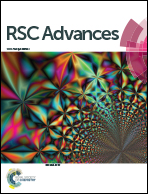Design of a multifunctional vanadium pentoxide/polymer biocomposite for implant-coating applications†
Abstract
In this study we designed a multifunctional implant coating by exploiting the properties of vanadium pentoxide (V2O5), i.e., the antibacterial activity via myeloperoxidase-like catalytic activity and the bioactivity of low concentrations of vanadate ions (dissolved form of V2O5) via the insulin-mimicking effect. To achieve this, the dissolution control of the V2O5 and the sustained release of the vanadate ions had to be achieved by processing the appropriate carrier system for the V2O5. Thus, we evaluated the ability of different polymeric carriers and the V2O5 particle morphology to modulate in vitro the stability of the prepared V2O5/polymeric coatings. For the control of the V2O5 dissolution it was crucial to control the diffusion of the particles from the polymeric matrix to the surrounding medium and to prevent extensive swelling of the polymer matrix. We highlighted the correlation between the strength of the interactions at the V2O5/polymer interface and the composite's stability under simulated physiological conditions. The optimum outcome was obtained for a nanowires-V2O5/PLGA composite coating that delivered vanadates sustainably, while at the same time preventing the colonization of S. epidermidis (NCIMB 8853) on its surface and ensuring the absence of any harmful effects on the red blood cells.



 Please wait while we load your content...
Please wait while we load your content...